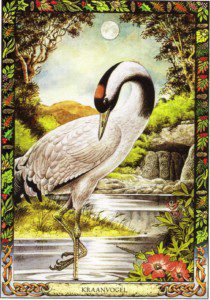
by Nimue Brown
Cranes became extinct in the UK about 400 years ago. However, there has been a recent project to reintroduce them. Normally when cranes breed, they lay two eggs. When the first egg hatches, they leave the nest, and that’s it for the second egg. The Wildfowl and Wetland Trust were able to capitalise on this, sending a team to Germany to collect up some of the second eggs. There’s no impact on the German crane population in doing this. Eggs were brought to Slimbridge, Gloucestershire and carefully reared.
Chicks bond with whatever they see as parents, so this process involved crane suits and pretend beaks for the humans in the project. Mature cranes were taken down to the Somerset levels (that’s the Glastonbury area for people further afield) and released at a secret location.
Then things got interesting. Eight of the cranes came back. It’s a fair journey, and they travelled it in boxes the first time. How did they return? We don’t know. They started appearing in the fields around the Wetlands Centre, to great surprise. Then, this spring, a pair started nest building at Slimbridge. It’s a historic moment, because if they manage it, this will be the first truly wild born crane for 400 years.
Living on the canal near the Wetlands centre, I have been fortunate enough to see cranes in flight on a number of occasions now. Larger than herons, their great, dipping wings are a dramatic sight. They tend to fly in groups of two or more, and the sight of four together in the air is breath-taking. Between the captive population and the wild eight, in the evenings I often hear the musical, haunting call of the cranes. Once, this part of the wold was marshland, inhabited by my Stone Age ancestors. The cry of the cranes seems to me like an echo of their world.
There’s a grace to cranes, an elegance of form combined with economy of movement. They stalk through the rushes, and when still are almost impossible to spot. Once we had a lot more wetland in this country. We’ve drained the marshes, tried to control the rivers. All our water management efforts have actually made us more vulnerable to flooding. We humans need those wetlands back to soak up the heavy rains. The cranes need them even more.
We’re so prone, as a species, to valuing other life forms in terms of their utility. We forget all too easily that nature isn’t here to serve us. That said, the cranes have come to give us a second chance, to try and put right something we got badly wrong. They come with beauty, and mystery. I only hope we can listen to them and get things right this time.
For fascinating information for the crane-lover, click here.